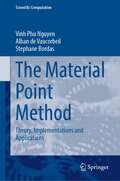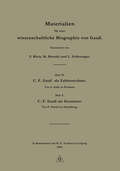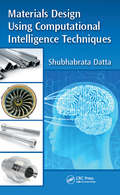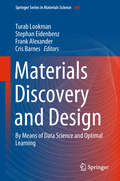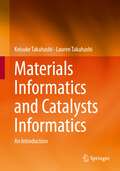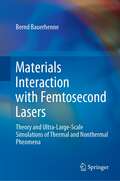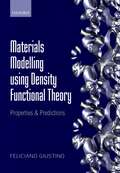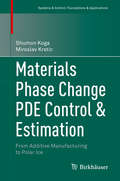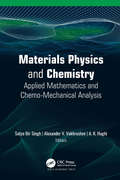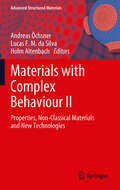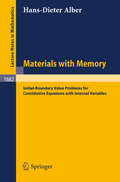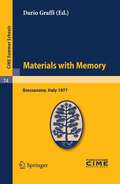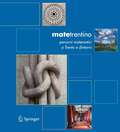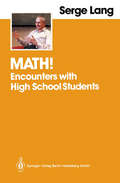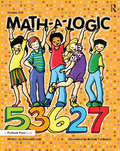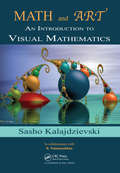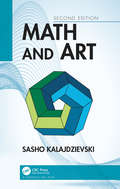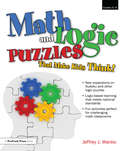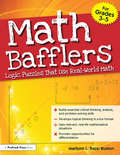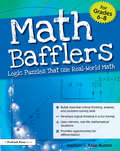- Table View
- List View
The Material Point Method: Theory, Implementations and Applications (Scientific Computation)
by Vinh Phu Nguyen Alban de Vaucorbeil Stephane BordasThis book provides an introduction to the fundamental theory, practical implementation, and core and emerging applications of the material point method (MPM) and its variants. The MPM combines the advantages of both finite element analysis (FEM) and meshless/meshfree methods (MMs) by representing the material by a set of particles overlaid on a background mesh that serves as a computational scratchpad.The book shows how MPM allows a robust, accurate, and efficient simulation of a wide variety of material behaviors without requiring overly complex implementations. MPM and its variants have been shown to be successful in simulating a large number of high deformation and complicated engineering problems such as densification of foam, sea ice dynamics, landslides, and energetic device explosions, to name a few, and have recently found applications in the movie industry. It is hoped that this comprehensive exposition on MPM variants and their applications will not only provide an opportunity to re-examine previous contributions, but also to re-organize them in a coherent fashion and in anticipation of new advances.Sample algorithms for the solutions of benchmark problems are provided online so that researchers and graduate students can modify these algorithms and develop their own solution algorithms for specific problems. The goal of this book is to provide students and researchers with a theoretical and practical knowledge of the material point method to analyze engineering problems, and it may help initiate and promote further in-depth studies on the subjects discussed.
Materialien für eine wissenschaftliche Biographie von Gauß
by F. Klein M. Brendel L. SchlesingerDieser Buchtitel ist Teil des Digitalisierungsprojekts Springer Book Archives mit Publikationen, die seit den Anfängen des Verlags von 1842 erschienen sind. Der Verlag stellt mit diesem Archiv Quellen für die historische wie auch die disziplingeschichtliche Forschung zur Verfügung, die jeweils im historischen Kontext betrachtet werden müssen. Dieser Titel erschien in der Zeit vor 1945 und wird daher in seiner zeittypischen politisch-ideologischen Ausrichtung vom Verlag nicht beworben.
Materials Design Using Computational Intelligence Techniques
by Shubhabrata DattaSeveral statistical techniques are used for the design of materials through extraction of knowledge from existing data banks. These approaches are getting more attention with the application of computational intelligence techniques. This book illustrates the alternative but effective methods of designing materials, where models are developed through capturing the inherent correlations among the variables on the basis of available imprecise knowledge in the form of rules or database, as well as through the extraction of knowledge from experimental or industrial database, and using optimization tools.
Materials Design Using Computational Intelligence Techniques
by Shubhabrata DattaSeveral statistical techniques are used for the design of materials through extraction of knowledge from existing data banks. These approaches are getting more attention with the application of computational intelligence techniques. This book illustrates the alternative but effective methods of designing materials, where models are developed through capturing the inherent correlations among the variables on the basis of available imprecise knowledge in the form of rules or database, as well as through the extraction of knowledge from experimental or industrial database, and using optimization tools.
Materials Discovery and Design: By Means of Data Science and Optimal Learning (Springer Series in Materials Science #280)
by Turab Lookman Stephan Eidenbenz Frank Alexander Cris BarnesThis book addresses the current status, challenges and future directions of data-driven materials discovery and design. It presents the analysis and learning from data as a key theme in many science and cyber related applications. The challenging open questions as well as future directions in the application of data science to materials problems are sketched. Computational and experimental facilities today generate vast amounts of data at an unprecedented rate. The book gives guidance to discover new knowledge that enables materials innovation to address grand challenges in energy, environment and security, the clearer link needed between the data from these facilities and the theory and underlying science. The role of inference and optimization methods in distilling the data and constraining predictions using insights and results from theory is key to achieving the desired goals of real time analysis and feedback. Thus, the importance of this book lies in emphasizing that the full value of knowledge driven discovery using data can only be realized by integrating statistical and information sciences with materials science, which is increasingly dependent on high throughput and large scale computational and experimental data gathering efforts. This is especially the case as we enter a new era of big data in materials science with the planning of future experimental facilities such as the Linac Coherent Light Source at Stanford (LCLS-II), the European X-ray Free Electron Laser (EXFEL) and MaRIE (Matter Radiation in Extremes), the signature concept facility from Los Alamos National Laboratory. These facilities are expected to generate hundreds of terabytes to several petabytes of in situ spatially and temporally resolved data per sample. The questions that then arise include how we can learn from the data to accelerate the processing and analysis of reconstructed microstructure, rapidly map spatially resolved properties from high throughput data, devise diagnostics for pattern detection, and guide experiments towards desired targeted properties. The authors are an interdisciplinary group of leading experts who bring the excitement of the nascent and rapidly emerging field of materials informatics to the reader.
Materials Informatics and Catalysts Informatics: An Introduction
by Keisuke Takahashi Lauren TakahashiThis textbook is designed for students and researchers who are interested in materials and catalysts informatics with little to no prior experience in data science or programming languages. Starting with a comprehensive overview of the concept and historical context of materials and catalysts informatics, it serves as a guide for establishing a robust materials informatics environment. This essential resource is designed to teach vital skills and techniques required for conducting informatics-driven research, including the intersection of hardware, software, programming, machine learning within the field of data science and informatics. Readers will explore fundamental programming techniques, with a specific focus on Python, a versatile and widely-used language in the field. The textbook explores various machine learning techniques, equipping learners with the knowledge to harness the power of data science effectively. The textbook provides Python code examples, demonstrating materials informatics applications, and offers a deeper understanding through real-world case studies using materials and catalysts data. This practical exposure ensures readers are fully prepared to embark on their informatics-driven research endeavors upon completing the textbook. Instructors will also find immense value in this resource, as it consolidates the skills and information required for materials informatics into one comprehensive repository. This streamlines the course development process, significantly reducing the time spent on creating course material. Instructors can leverage this solid foundation to craft engaging and informative lecture content, making the teaching process more efficient and effective.
Materials Interaction with Femtosecond Lasers: Theory and Ultra-Large-Scale Simulations of Thermal and Nonthermal Pheomena
by Bernd BauerhenneThis book presents a unified view of the response of materials as a result of femtosecond laser excitation, introducing a general theory that captures both ultrashort-time non-thermal and long-time thermal phenomena. It includes a novel method for performing ultra-large-scale molecular dynamics simulations extending into experimental and technological spatial dimensions with ab-initio precision. For this, it introduces a new class of interatomic potentials, constructed from ab-initio data with the help of a self-learning algorithm, and verified by direct comparison with experiments in two different materials — the semiconductor silicon and the semimetal antimony.In addition to a detailed description of the new concepts introduced, as well as giving a timely review of ultrafast phenomena, the book provides a rigorous introduction to the field of laser–matter interaction and ab-initio description of solids, delivering a complete and self-contained examination of the topic from the very first principles. It explains, step by step from the basic physical principles, the underlying concepts in quantum mechanics, solid-state physics, thermodynamics, statistical mechanics, and electrodynamics, introducing all necessary mathematical theorems as well as their proofs. A collection of appendices provide the reader with an appropriate review of many fundamental mathematical concepts, as well as important analytical and numerical parameters used in the simulations.
Materials Modelling using Density Functional Theory: Properties and Predictions
by Feliciano GiustinoThis book is an introduction to the quantum theory of materials and first-principles computational materials modelling. It explains how to use density functional theory as a practical tool for calculating the properties of materials without using any empirical parameters. The structural, mechanical, optical, electrical, and magnetic properties of materials are described within a single unified conceptual framework, rooted in the Schrödinger equation of quantum mechanics, and powered by density functional theory. This book is intended for senior undergraduate and first-year graduate students in materials science, physics, chemistry, and engineering who are approaching for the first time the study of materials at the atomic scale. The inspiring principle of the book is borrowed from one of the slogans of the Perl programming language, 'Easy things should be easy and hard things should be possible'. Following this philosophy, emphasis is placed on the unifying concepts, and on the frequent use of simple heuristic arguments to build on one's own intuition. The presentation style is somewhat cross disciplinary; an attempt is made to seamlessly combine materials science, quantum mechanics, electrodynamics, and numerical analysis, without using a compartmentalized approach. Each chapter is accompanied by an extensive set of references to the original scientific literature and by exercises where all key steps and final results are indicated in order to facilitate learning. This book can be used either as a complement to the quantum theory of materials, or as a primer in modern techniques of computational materials modelling using density functional theory.
Materials Phase Change PDE Control & Estimation: From Additive Manufacturing to Polar Ice (Systems & Control: Foundations & Applications)
by Shumon Koga Miroslav KrsticThis monograph introduces breakthrough control algorithms for partial differential equation models with moving boundaries, the study of which is known as the Stefan problem. The algorithms can be used to improve the performance of various processes with phase changes, such as additive manufacturing. Using the authors' innovative design solutions, readers will also be equipped to apply estimation algorithms for real-world phase change dynamics, from polar ice to lithium-ion batteries.A historical treatment of the Stefan problem opens the book, situating readers in the larger context of the area. Following this, the chapters are organized into two parts. The first presents the design method and analysis of the boundary control and estimation algorithms. Part two then explores a number of applications, such as 3D printing via screw extrusion and laser sintering, and also discusses the experimental verifications conducted. A number of open problems and provided as well, offering readers multiple paths to explore in future research.Materials Phase Change PDE Control & Estimation is ideal for researchers and graduate students working on control and dynamical systems, and particularly those studying partial differential equations and moving boundaries. It will also appeal to industrial engineers and graduate students in engineering who are interested in this area.
Materials Physics and Chemistry: Applied Mathematics and Chemo-Mechanical Analysis
by Satya Bir Singh Alexander V. Vakhrushev A. K. HaghiThis volume focuses on the development and application of fundamental concepts in mechanics and physics of solids as they pertain to the solution of challenging new problems in diverse areas, such as materials science and micro- and nanotechnology. In this volume, emphasis is placed on the development of fundamental concepts of mechanics and novel applications of these concepts based on theoretical, experimental, or computational approaches, drawing upon the various branches of engineering science and the allied areas within applied mathematics, materials science, and applied physics.Materials Physics and Chemistry: Applied Mathematics and Chemo-Mechanical Analysis emphasizes the basics, such as design, equilibrium, material behavior, and geometry of deformation in simple structures or machines. Readers will find a thorough treatment of stress, strain, and the stress-strain relationships. Meanwhile it provides a solid foundation upon which readers can begin work in composite materials science and engineering. Many chapters include theory components with the equations students need to calculate different properties.
Materials with Complex Behaviour II: Properties, Non-Classical Materials and New Technologies (Advanced Structured Materials #16)
by Andreas Öchsner, Lucas F. M. Silva and Holm AltenbachThis volume highlights the latest developments and trends in advanced materials and their properties, the modeling and simulation of non-classical materials and structures, and new technologies for joining materials. It presents the developments of advanced materials and respective tools to characterize and predict the material properties and behavior.
Materials with Memory: Initial-Boundary Value Problems for Constitutive Equations with Internal Variables (Lecture Notes in Mathematics #1682)
by Hans-Dieter AlberThis book contributes to the mathematical theory of systems of differential equations consisting of the partial differential equations resulting from conservation of mass and momentum, and of constitutive equations with internal variables. The investigations are guided by the objective of proving existence and uniqueness, and are based on the idea of transforming the internal variables and the constitutive equations. A larger number of constitutive equations from the engineering sciences are presented. The book is therefore suitable not only for specialists, but also for mathematicians seeking for an introduction in the field, and for engineers with a sound mathematical background.
Materials with Memory: Lectures given at a Summer School of the Centro Internazionale Matematico Estivo (C.I.M.E.) held in Bressanone (Bolzano), Italy, June 2-11, 1977 (C.I.M.E. Summer Schools #74)
by Dario GraffiR. Bouc, G. Geymonat: Periodic problems in thermoviscoelasticity.- A. Day: The thermodynamics of materials with memory.- M. Fabrizio: Sulla nozione di stato nella termomeccanica dei continui.- G. Fichera: Analytic problems of hereditary phenomena.- M. Ribaric: The black box approach and systems with memory.- R.S. Rivlin: The theory of constitutive equations.-
matetrentino: percorsi matematici a Trento e dintorni
by Domenico Luminati Italo TamaniniQuesto libro e la mostra che esso racconta nascono dal desiderio di comunicare quanto possa essere bella e interessante una disciplina come la matematica e di avvicinare ad essa il "visitatore" curioso. Sono qui raccolti i testi e le immagini delle quattro aree tematiche (topologia, massimi e minimi, visualizzazione e simmetria) sviluppate nella mostra e illustrate prendendo spunto dalla realtà di Trento e del suo territorio. La mostra si terrà presso il Museo Tridentino di Scienze Naturali (www.mtsn.tn.it) dal 17 febbraio al 29 ottobre 2006.
Math-a-Logic: Grades 4-8
by Dianne DrazeIf you thought math was all numbers, you're in for a surprise. The ability to reason logically is both a prerequisite for learning mathematics and a desired outcome of mathematics instruction. Mathematics provides an excellent context in which to make students aware of the logical structures they need to function successfully in any setting. Math-A-Logic is an award-winning text that successfully merges logical thinking with mathematical concepts and calculations. Eight areas of logic are introduced: patterns and sequences, analogies, deduction, inference, sets and Venn diagram, propositions and logical notation, syllogisms, and logical problem solving. Attractive, reproducible worksheets lead students through each topic, providing explanations, examples, and exercises to test their understanding. With mathematics as the vehicle for presenting and practicing the logical concept, students get practice in mathematical concepts and computations while building thinking skills. The end result is clearer thinking and enhanced problem-solving abilities. This unique approach is sure to be a favorite supplement to your regular math program. The attractive illustrations, clear instructions, solid content, and ease of use make this book a winner. This book is the winner of Learning Magazine's Teacher Choice award. Grades 4-8
Math-a-Logic: Grades 4-8
by Dianne DrazeIf you thought math was all numbers, you're in for a surprise. The ability to reason logically is both a prerequisite for learning mathematics and a desired outcome of mathematics instruction. Mathematics provides an excellent context in which to make students aware of the logical structures they need to function successfully in any setting. Math-A-Logic is an award-winning text that successfully merges logical thinking with mathematical concepts and calculations. Eight areas of logic are introduced: patterns and sequences, analogies, deduction, inference, sets and Venn diagram, propositions and logical notation, syllogisms, and logical problem solving. Attractive, reproducible worksheets lead students through each topic, providing explanations, examples, and exercises to test their understanding. With mathematics as the vehicle for presenting and practicing the logical concept, students get practice in mathematical concepts and computations while building thinking skills. The end result is clearer thinking and enhanced problem-solving abilities. This unique approach is sure to be a favorite supplement to your regular math program. The attractive illustrations, clear instructions, solid content, and ease of use make this book a winner. This book is the winner of Learning Magazine's Teacher Choice award. Grades 4-8
Math and Art: An Introduction to Visual Mathematics
by Sasho KalajdzievskiMath and Art: An Introduction to Visual Mathematics explores the potential of mathematics to generate visually appealing objects and reveals some of the beauty of mathematics. With a CD-ROM and a 16-page full-color insert, it includes numerous illustrations, computer-generated graphics, photographs, and art reproductions to demonstrate how mathemat
Math and Art: An Introduction to Visual Mathematics
by Sasho KalajdzievskiMath and Art: An Introduction to Visual Mathematics explores the potential of mathematics to generate visually appealing objects and reveals some of the beauty of mathematics. It includes numerous illustrations, computer-generated graphics, photographs, and art reproductions to demonstrate how mathematics can inspire or generate art. Focusing on accessible, visually interesting, and mathematically relevant topics, the text unifies mathematics subjects through their visual and conceptual beauty. Sequentially organized according to mathematical maturity level, each chapter covers a cross section of mathematics, from fundamental Euclidean geometry, tilings, and fractals to hyperbolic geometry, platonic solids, and topology. For art students, the book stresses an understanding of the mathematical background of relatively complicated yet intriguing visual objects. For science students, it presents various elegant mathematical theories and notions. Features Provides an accessible introduction to mathematics in art Supports the narrative with a self-contained mathematical theory, with complete proofs of the main results (including the classification theorem for similarities) Presents hundreds of figures, illustrations, computer-generated graphics, designs, photographs, and art reproductions, mainly presented in full color Includes 21 projects and approximately 280 exercises, about half of which are fully solved Covers Euclidean geometry, golden section, Fibonacci numbers, symmetries, tilings, similarities, fractals, cellular automata, inversion, hyperbolic geometry, perspective drawing, Platonic and Archimedean solids, and topology New to the Second Edition New exercises, projects and artworks Revised, reorganized and expanded chapters More use of color throughout
Math and Art: An Introduction to Visual Mathematics
by Sasho KalajdzievskiMath and Art: An Introduction to Visual Mathematics explores the potential of mathematics to generate visually appealing objects and reveals some of the beauty of mathematics. It includes numerous illustrations, computer-generated graphics, photographs, and art reproductions to demonstrate how mathematics can inspire or generate art. Focusing on accessible, visually interesting, and mathematically relevant topics, the text unifies mathematics subjects through their visual and conceptual beauty. Sequentially organized according to mathematical maturity level, each chapter covers a cross section of mathematics, from fundamental Euclidean geometry, tilings, and fractals to hyperbolic geometry, platonic solids, and topology. For art students, the book stresses an understanding of the mathematical background of relatively complicated yet intriguing visual objects. For science students, it presents various elegant mathematical theories and notions. Features Provides an accessible introduction to mathematics in art Supports the narrative with a self-contained mathematical theory, with complete proofs of the main results (including the classification theorem for similarities) Presents hundreds of figures, illustrations, computer-generated graphics, designs, photographs, and art reproductions, mainly presented in full color Includes 21 projects and approximately 280 exercises, about half of which are fully solved Covers Euclidean geometry, golden section, Fibonacci numbers, symmetries, tilings, similarities, fractals, cellular automata, inversion, hyperbolic geometry, perspective drawing, Platonic and Archimedean solids, and topology New to the Second Edition New exercises, projects and artworks Revised, reorganized and expanded chapters More use of color throughout
Math and Logic Puzzles That Make Kids Think!: Grades 6-8
by Jeffrey J. WankoKids love exploring new ways of solving problems, especially in fun and challenging puzzle formats. In Math and Logic Puzzles That Make Kids Think!, the author presents several variations on Sudoku—the most well-known type of logic puzzle—in an easy-to-use, exciting format perfect for any math classroom. These language-independent logic puzzles provide kids with great problems to stretch how they think and reason.Each puzzle variation utilizes some of the basic strategies of Sudoku puzzles, but each one also draws upon other areas of mathematics—ordering of numbers, properties of geometric shapes, basic operations, or enriched number sense. This book provides teachers with puzzles arranged by difficulty level that can be used to support and enhance students' mathematical investigations. It also provides a new and exciting context for the development of students' deductive reasoning skills, which can lay the foundation for further mathematical exploration.Grades 6-8
Math and Logic Puzzles That Make Kids Think!: Grades 6-8
by Jeffrey J. WankoKids love exploring new ways of solving problems, especially in fun and challenging puzzle formats. In Math and Logic Puzzles That Make Kids Think!, the author presents several variations on Sudoku—the most well-known type of logic puzzle—in an easy-to-use, exciting format perfect for any math classroom. These language-independent logic puzzles provide kids with great problems to stretch how they think and reason.Each puzzle variation utilizes some of the basic strategies of Sudoku puzzles, but each one also draws upon other areas of mathematics—ordering of numbers, properties of geometric shapes, basic operations, or enriched number sense. This book provides teachers with puzzles arranged by difficulty level that can be used to support and enhance students' mathematical investigations. It also provides a new and exciting context for the development of students' deductive reasoning skills, which can lay the foundation for further mathematical exploration.Grades 6-8
Math Bafflers: Logic Puzzles That Use Real-World Math (Grades 3-5)
by Marilynn L. Rapp BuxtonMath Bafflers requires students to use creativity, critical thinking, and logical reasoning to perform a variety of operations and practice skills that align with state and national math standards. The book covers real-life situations requiring math skills, such as distance, liquid measures, money, time, weight, sequencing, comparison, age, area, and percentages, along with operations such as fractions, exponents, algebra, place value, and number lines. Students will make hypotheses, organize information, draw conclusions, and use syllogistic thinking. Teachers can feel confident that they are providing challenges and reinforcing important skills in a format that students enjoy! Math Bafflers builds essential critical thinking, analysis, and problem-solving skills; develops logical thinking in a fun format; uses relevant, real-life mathematical situations; and provides opportunities for differentiation. Grades 3-5
Math Bafflers: Logic Puzzles That Use Real-World Math (Grades 3-5)
by Marilynn L. Rapp BuxtonMath Bafflers requires students to use creativity, critical thinking, and logical reasoning to perform a variety of operations and practice skills that align with state and national math standards. The book covers real-life situations requiring math skills, such as distance, liquid measures, money, time, weight, sequencing, comparison, age, area, and percentages, along with operations such as fractions, exponents, algebra, place value, and number lines. Students will make hypotheses, organize information, draw conclusions, and use syllogistic thinking. Teachers can feel confident that they are providing challenges and reinforcing important skills in a format that students enjoy! Math Bafflers builds essential critical thinking, analysis, and problem-solving skills; develops logical thinking in a fun format; uses relevant, real-life mathematical situations; and provides opportunities for differentiation. Grades 3-5
Math Bafflers: Logic Puzzles That Use Real-World Math (Grades 6-8)
by Marilynn L. Rapp BuxtonMath Bafflers requires students to use creativity, critical thinking, and logical reasoning to perform a variety of operations and practice skills that align with state and national math standards. The book covers real-life situations requiring math skills, such as distance, liquid measures, money, time, weight, sequencing, comparison, age, area, and percentages, along with operations such as fractions, exponents, algebra, place value, and number lines. Students will make hypotheses, organize information, draw conclusions, and use syllogistic thinking. Teachers can feel confident that they are providing challenges and reinforcing important skills in a format that students enjoy! Math Bafflers builds essential critical thinking, analysis, and problem-solving skills; develops logical thinking in a fun format; uses relevant, real-life mathematical situations; and provides opportunities for differentiation. Grades 6-8
